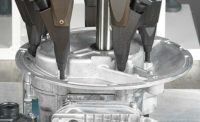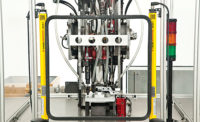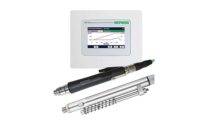Automatic Screwdriving Opens Window to Productivity
A systems integrator, a motor manufacturer and a screwdriving supplier collaborate to increase productivity and quality at ROMA.










Window blinds, shutters and screens have numerous functions. They control lighting, save energy, ensure privacy, provide security, and protect against the elements.
They’re also big business. According to consulting firm Persistence Market Research, global sales of window blinds alone are expected to grow at a compound annual rate of 3.6 percent over the next several years, topping $2.4 billion by 2027.
That’s good news for ROMA KG. Based in Burgau, Germany, ROMA makes roller shutters, external Venetian blinds, textile screens and garage doors. Founded in 1980, the company employs some 1,300 people at six locations throughout Europe. The company’s products are known for their functionality, aesthetics and durability. To meet quality and volume demands, the company’s manufacturing processes are highly automated, including the installation of threaded fasteners.
ROMA’s chief automation partner is distributor, contract manufacturer and systems integrator SOGA Gallenbach GmbH. Based in Pforzheim, Germany, SOGA specializes in assembly and test machines, sawing machines, press workstations, and brushing machines for cleaning and descaling parts. The company’s customers include manufacturers in the automotive, aerospace, medical and jewelry industries.
“We provide our customers with special machines that can be used in production immediately after delivery,” explains Fabian Gallenbach, SOGA’s managing director. “[Our customers tend to have] particularly stringent requirements when it comes to precision.”
Gallenbach knows all about precision manufacturing, having begun his career at a Swiss watch manufacturer. When he helped launch SOGA some 16 years ago, Gallenbach wanted to bring that same level of dedication to the automation business. “We hardly ever get simple enquires anymore,” he says.
Most recently, for example, SOGA designed and built an automated system to drill holes and install screws into profile rails for ROMA’s products. The system is equipped with several automatic screwdriving units that reliably control the depth and torque of each screw installation. The motion control technology for the system, including servomotors, controllers, planetary gear sets and rack-and-pinion drives, were provided by STÖBER, which is also located in Pforzheim. The screwdriving units were provided by DEPRAG.
Screwdriving Without Rework
ROMA had long used automated equipment to drill holes and install screws in aluminum and plastic profile rails, which range from 2.3 to 18.7 feet in length. However, that equipment did not have monitoring features.
With the original equipment, “shavings are often created between the screw head and profile rails, particularly when drilling in wrought aluminum alloys,” explains Gallenbach.
The shavings are a problem, because an end cap is attached to the screw to improve aesthetics, and the shavings can prevent the cap from attaching properly. Assemblers would have to manually rework each fastening location time and again. ROMA wanted to prevent that.
“Over the past 15 years, we have developed more than 50 screwdriving stations with torques from 0.4 to 200 newton-meters,” reports Gallenbach. “We have enabled our customers to assemble screws without manual retightening or reworking.”
SOGA developed a screwdriving system that monitors depth and torque of each screw. “We have developed a strategy, particularly for driving screws into plastic, in which a pneumatic screwdriver works with pressure pulses,” explains Gallenbach.
Plastic does not require a higher final torque for tightening than for the entire screwdriving process. Therefore, the machine must be sensitive.
SOGA’s engineers also equipped the system with two drawers for storing the profile rails. The machine can feed the profiles separately or synchronously. The components are inserted and clamped manually.
Motors, Gears and Drivers
STÖBER was a key partner in developing the system. The drawers move over two Y axes in automatic mode, describes Guido Wittenauer, a STÖBER sales representative. STÖBER supplied its EZ synchronous servomotor for each drawer, combined with a PE series planetary gear and a belt and spindle drive.
The system automatically feeds the screws and assembles them pneumatically. The station is equipped with five assembly heads that move independently from one another in the X direction on a rack.
Each head is equipped with a Z axis and a drilling axis, says Wittenauer. For the X axis, STÖBER supplied ZVPE series rack-and-pinion drives, as well as EZ synchronous servomotors. For the Z axis, EZ motors with spindle drives were also used.
To prevent the five heads from colliding with one another on the rack, STÖBER engineers implemented a three-fold collision prevention concept. The controller monitors the position of each head in relation to one another. Engineers then used software to create a digital limit switch that sets the permissible traversing range for each X axis. Just in case, a mechanical safety switch is also located on each head.
The screwdriving units were supplied by DEPRAG. The torque range for units can be individually adjusted to specific screwdriving tasks.
“The wide spectrum of our standard modules provides an efficient solution for every screwdriving task. And even specialized applications can be realized individually and at low cost based on our broad range of standard programs,” says Daniel Guttenberger, product manager for DEPRAG.
The screws needed are fed using DEPRAG’s eacy feed vibratory bowl feeder. This means that all five screwdriving units can be supplied by only one feeding device. This is made possible by the use of a vibratory bowl with double spiral in combination with a threefold separator.
For the drill spindles, a lightweight, compact motor was needed to keep the moveable mass of the five axes as low as possible for fast positioning, describes Wittenauer. In addition to drilling, countersinking was also required as an option, necessitating highly dynamic motor regulators.
With this is mind, STÖBER supplied its new LeanMotor (LM). The motor’s speed and torque can be smoothly regulated from standstill up to maximum speed with full torque control. The motor functions without an encoder. As a result, the motor is significantly more compact and lightweight than an asynchronous drive, and more robust and cost effective than a servo drive. Working at up to 96 percent efficiency, the motor can attain efficiency class IE5. That means the motor uses less energy and will last longer.
“Because our LeanMotor works without an encoder, it also only needs a standard power cable without additional wires or shielding,” adds Wittenauer.
Reliability in the Background
STÖBER has combined the motors with nine double-axis controllers from the SI6 series. This highly dynamic system works reliably in the background, even when sophisticated movements are needed. The safety functions STO (safe torque off) and SS1 (safe stop 1) are integrated into each controller and certified according to EN 13849-1 (PL e, Cat. 4).
Just 45 millimeters wide, the controller is designed as a modular device, says Wittenauer. A single device can control up to two axes. By stringing together several controllers, the number of axes to be controlled can be freely scaled.
Installation of the individual controllers is easy: STÖBER’s Quick-DC-Link modules enable standard copper rails to simply be clicked into place for energy distribution. STÖBER also supports communication via the Profinet fieldbus.
In addition to supplying the motion control components, STÖBER also helped with the mechanical design and dimensioning. Support from STÖBER’s engineers began as early as the quotation phase. Together, both STÖBER and SOGA discussed the critical points and worked through them step by step.
“The idea of using a motor with helical gearing to create a unit for the X axis was developed together during project discussions,” says Gallenbach.
“The design of our entire machine concept was based on the calculations, amongst other things, of the motor technology,” adds Gallenbach. “If an error occurred at the design stage, the entire automation could have been compromised.”
The standardization and modular design of DEPRAG’s screwdriving units helped to reduce the time and cost of the system. “Our standards for screwdriving units are straightforward and cleverly devised. This means that significantly shorter planning and delivery times can be achieved,” explains Guttenberger.
For more information on screwdriving systems, visit DEPRAG’s website at www.depragusa.com. For more information on motion control technology, visit STÖBER’s website at www.stoeber.de. For more information on special machines, visit SOGA’s website at https://soga.de.
Looking for a reprint of this article?
From high-res PDFs to custom plaques, order your copy today!











